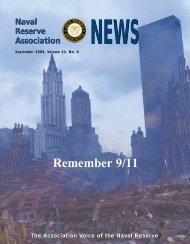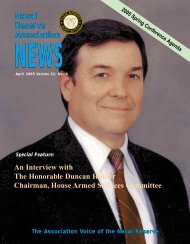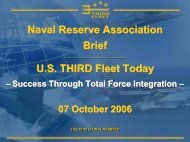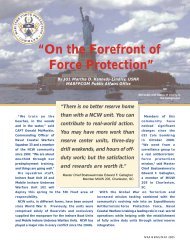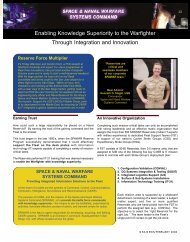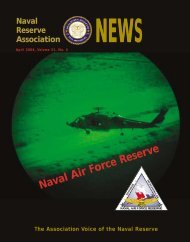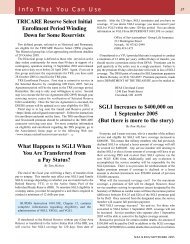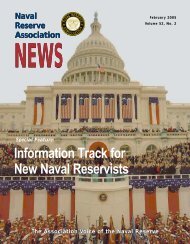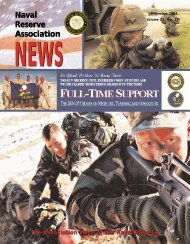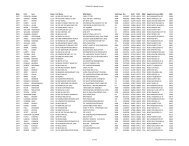Naval Reserve Association Naval Reserve Association
Naval Reserve Association Naval Reserve Association
Naval Reserve Association Naval Reserve Association
Create successful ePaper yourself
Turn your PDF publications into a flip-book with our unique Google optimized e-Paper software.
12<br />
Human Capital Index (HCI), a feature that shows how the Sailor<br />
is performing against the average [normalized] score of those in<br />
the same rating and of the same rank.<br />
Everyone recognizes our Reservists bring more to the table<br />
than just their military training; they possess tremendous civilian<br />
skills that increase their ability to serve. As part of Sea Warrior,<br />
the Navy [and DoD] is interested in capturing this data and<br />
ultimately rewarding Sailors for these skills in their 5VM. Every<br />
Navy Drilling Reservist (Selected Reservist and Voluntary<br />
Training Unit member) is required by DoD to provide their<br />
civilian employment data and, most importantly, their actual<br />
civilian skill competencies.<br />
In July 2004, our Reservists began filling out an on-line<br />
questionnaire that assesses their competencies in a variety of<br />
skills. It incorporates a number of elements such as tasks<br />
performed, tools used, unique knowledge required, and resources.<br />
By FY ’06, all Navy personnel will have a résume, reflecting both<br />
Navy and civilian training/experience, displayed on their Sea<br />
Warrior 5VM and used for billet assignments, active-duty<br />
opportunities, rating/designator changes, and advancement.<br />
Everything we do is about support to the fleet; and one of the<br />
most critical functions we perform at <strong>Reserve</strong> Forces Command<br />
is a focus on customer service, which enables our Sailors to go<br />
forward and serve. We’re continuously working on improving our<br />
quality of service; so, last year, we stood up the Customer Service<br />
Directorate, led by Selected Reservists who are completely devoted<br />
to this mission. They issued an electronic survey this past spring<br />
to capture force-wide metrics on how our Reservists feel they are<br />
being supported by the Navy <strong>Reserve</strong>. The results will be collated,<br />
evaluated, and released in early August. From there, the Customer<br />
Service Directorate will work to develop an improvement plan,<br />
communicate the strategy back to the force, and conduct follow-up<br />
analysis.<br />
Our Financial Directorate is completing the development of<br />
two Activity Based Costing (ABC) models that will significantly<br />
enhance Navy leadership’s ability to make informed decisions<br />
about the Navy <strong>Reserve</strong>.<br />
The first model is a business tool which can be used to determine<br />
what activities, performed by each echelon, are necessary to produce<br />
the desired three Navy <strong>Reserve</strong> products:<br />
A Mission-Ready Sailor<br />
Mission-Ready Hardware<br />
Operational Support<br />
At the end of August 2004, we will have determined the unit<br />
cost for each of these products and will recommend ways to optimize<br />
the allocation of resources to achieve cost-effective, missionready<br />
Sailors, mission-ready hardware, and operational support to<br />
the Navy.<br />
The second model is sponsored by OPNAV and is designed to<br />
model the Operations and Maintenance, <strong>Naval</strong> <strong>Reserve</strong> (O&M,<br />
NR) costs to the Navy <strong>Reserve</strong>. The “SELRES Support ABC<br />
Model,” as it’s called, will demonstrate how cuts in the O&M, NR<br />
budget would affect Navy <strong>Reserve</strong> readiness and performance.<br />
This is one of the few remaining budget items that isn’t modeled<br />
at another level, and it’s a shining example of Active/<br />
<strong>Reserve</strong> Integration, as we work with OPNAV and the<br />
Financial Management Branch (FMB) in this effort.<br />
Everything we do must lead towards improved readiness. In<br />
2003, our Operations Department began a tremendous initiative<br />
to enable Navy to view Navy <strong>Reserve</strong> readiness information<br />
through the TYCOM Readiness Management System (TRMS).<br />
We created an innovative module called the Navy <strong>Reserve</strong><br />
Readiness Module (NRRM) that currently links to databases,<br />
such as <strong>Reserve</strong> Automated Medical Interim System (RAMIS);<br />
the Navy <strong>Reserve</strong> Order Writing System (NROWS); the <strong>Reserve</strong><br />
Headquarters System (RHS); and, soon, the Navy Marine Corps<br />
Processing System (NMCMPS), to name a few. Through the<br />
TRMS/NRRM viewer, Navy can see the following while a<br />
Reservist is performing most types of active-duty service<br />
(excluding ADSW and mobilizations):<br />
The cost associated with Reservist’s orders<br />
What SEAPOWER function the Reservist is supporting<br />
Where they are physically serving and details about their<br />
orders<br />
Where they are in the mobilization/demobilization process<br />
(once NMCMPS comes on-line)<br />
If the advertised billet and NEC/Designator code of the<br />
Reservist filling the billet are an appropriate match<br />
Numbers of people by types of orders or ratings serving in<br />
certain geographical regions<br />
More . . . .<br />
We are currently working with BUPERS to link ADSW and<br />
mobilization data to TRMS/NRRM and ultimately to transition to<br />
a single order-writing system that can be viewed through<br />
TRMS/NRRM.<br />
NMCMPS is the Navy version of the Marine Corps Mobilization<br />
Processing System, developed in partnership with BUPERS. It<br />
tracks each Reservist’s movement through the mobilization and<br />
demobilization process by using a Web-based electronic checklist.<br />
This system has been a huge success in managing these processes;<br />
and, once linked to TRMS/NRRM, it will afford decision makers<br />
visibility of this significant data.<br />
One of our greatest successes at <strong>Reserve</strong> Forces Command has<br />
been the development of the Web-based <strong>Naval</strong> <strong>Reserve</strong> Order<br />
Writing System (NROWS). Both active-duty and <strong>Reserve</strong> personnel<br />
applaud this system because it allows the Reservist to process<br />
electronically their application expeditiously, and it offers a<br />
tracking mechanism. Each service member in the order-approval<br />
chain-of-command can see the application and endorse, hold, or<br />
reject the application. Once approved, the Reservist can simply<br />
print his/her orders from any PC, a great time-saver. NROWS<br />
also offers a financial function that projects the cost of each set<br />
of orders and tracks the execution of orders. This accounting tool<br />
affords the approving authority data critical to making decisions.<br />
Another major achievement and key database for the<br />
TRMS/NRRM viewer is our medical department’s <strong>Reserve</strong><br />
Automated Medical Information System (RAMIS). This system<br />
was built in 2002 to capture and report detailed individual and<br />
unit level <strong>Reserve</strong> medical information. Far more robust than the<br />
active-duty SNAP {Shipboard ADP Program} Automated<br />
Medical System (SAMS), Web-based RAMIS enables active and<br />
<strong>Reserve</strong> medical decision makers to coordinate personnel and<br />
supplies to ensure the completion of comprehensive medical care.<br />
It also affords real-time visibility to the chain of command on<br />
NRA NEWS/AUGUST 2004



